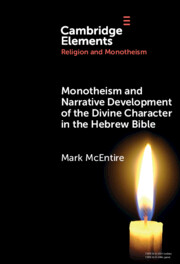Monotheism and Narrative Development of the Divine Character in the Hebrew Bible
Published online by Cambridge University Press:
29 November 2023
- Mark McEntire
- Affiliation:
Belmont University
Summary
The preeminent example of monotheism, the God of the Hebrew Bible, is the end product of a long process. The world from which this literature emerged was polytheistic. The nature and arrangement of the literature diminishes polytheistic realities and enhances the effort to portray a single divine being. The development of this divine character through the course of a sustained narrative with a sequential plot aided the move toward monotheism by allowing for the placement of diverse, even conflicting, portrayals of the deity at distant points along the plot line. Through the sequence of events the divine character becomes more withdrawn from the sphere of human activity, more aged in appearance and behavior, and increasingly disembodied. All these characteristics lend themselves to the presentation of disparate narrative portrayals as a singular subject in this Element.

